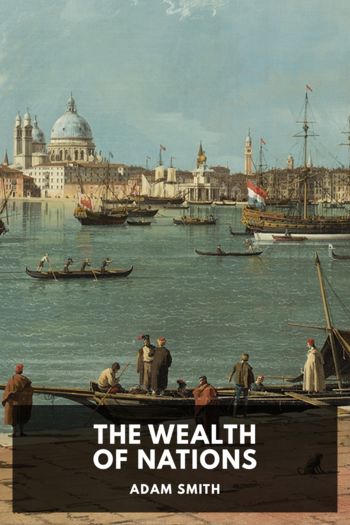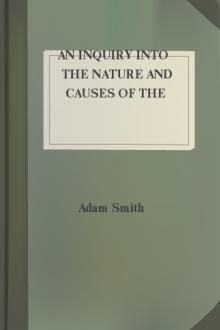The Wealth of Nations, Adam Smith [english novels to improve english .TXT] 📗

- Author: Adam Smith
Book online «The Wealth of Nations, Adam Smith [english novels to improve english .TXT] 📗». Author Adam Smith
Ed. 1 reads “improvements.” ↩
Ed. 1 reads “Though in them.” ↩
Another and perhaps more important reason for taking an example like that which follows is the possibility of exhibiting the advantages of division of labour in statistical form. ↩
This parenthesis would alone be sufficient to show that those are wrong who believe Smith did not include the separation of employments in “division of labour.” ↩
In Adam Smith’s Lectures, p. 164, the business is, as here, divided into eighteen operations. This number is doubtless taken from the Encyclopédie, tom. v (published in 1755), s.v. Épingle. The article is ascribed to M. Delaire, “qui décrivait la fabrication de l’épingle dans les ateliers même des ouvriers,” p. 807. In some factories the division was carried further. E. Chambers, Cyclopædia, vol. ii, 2nd ed., 1738, and 4th ed., 1741, s.v. Pin, makes the number of separate operations twenty-five. ↩
Ed. 1 reads “the.” ↩
Ed. 1 reads “the lands” here and two lines higher up. ↩
Ed. 1 reads “because the silk manufacture does not suit the climate of England.” ↩
In Lectures, p. 164, the comparison is between English and French “toys,” i.e., small metal articles. ↩
Ed. 1 places “in consequence of the division of labour” here instead of in the line above. ↩
“Pour la célérité du travail et la perfection de l’ouvrage, elles dépendent entièrement de la multitude des ouvriers rassemblés. Lorsqu’une manufacture est nombreuse, chaque opération occupe un homme différent. Tel ouvrier ne fait et ne fera de sa vie qu’une seule et unique chose; tel autre une autre chose: d’où il arrive que chacune s’exécute bien et promptement, et que l’ouvrage le mieux fait est encore celui qu’on a à meilleur marché. D’ailleurs le goût et la façon se perfectionnent nécessairement entre un grand nombre d’ouvriers, parce qu’il est difficile qu’il ne s’en rencontre quelquesuns capables de réfléchir, de combiner, et de trouver enfin le seul moyen qui puisse les mettre audessus de leurs semblables; le moyen ou d’épargner la matière, ou d’allonger le temps, ou de surfaire l’industrie, soit par une machine nouvelle, soit par une maneuver plus commode.” —Encyclopédie, tom i (1751), p. 717, s.v. Art. All three advantages mentioned in the text above are included here. ↩
In Lectures, p. 166, “a country smith not accustomed to make nails will work very hard for three or four hundred a day and those too very bad.” ↩
In Lectures, p. 166, “a boy used to it will easily make two thousand and those incomparably better.” ↩
In Lectures, p. 255, it is implied that the labour of making a button was divided among eighty persons. ↩
The same example occurs in Lectures, p. 166. ↩
Examples are given in Lectures, p. 167: “Two men and three horses will do more in a day with the plough than twenty men without it. The miller and his servant will do more with the water mill than a dozen with the hand mill, though it too be a machine.” ↩
Ed. 1 reads “I shall, therefore, only observe.” ↩
Ed. 1 reads “machines employed.” ↩
Ed. 1 reads “of common.” ↩
I.e., steam-engines. ↩
This pretty story is largely, at any rate, mythical. It appears to have grown out of a misreading (not necessarily by Smith) of the following passage: “They used before to work with a buoy in the cylinder enclosed in a pipe, which buoy rose when the steam was strong, and opened the injection, and made a stroke; thereby they were capable of only giving six, eight or ten strokes in a minute, till a boy, Humphry Potter, who attended the engine, added (what he called ‘scoggan’) a catch that the beam Q always opened; and then it would go fifteen or sixteen strokes in a minute. But this being perplexed with catches and strings, Mr. Henry Beighton, in an engine he had built at Newcastle-on-Tyne in 1718, took them all away, the beam itself simply supplying all much better.” —J. T. Desaguliers, Course of Experimental Philosophy, vol. ii, 1744, p. 533. From pp. 469, 471, it appears that hand labour was originally used before the “buoy” was devised. ↩
In Lectures, p. 167, the invention of the plough is conjecturally attributed to a farmer and that of the hand-mill to a slave, while the invention of the waterwheel and the steam engine is credited to philosophers. Mandeville is very much less favourable to the claims of the philosophers: “They are very seldom the same sort of people, those that invent arts and improvements in them and those that inquire into the reason of things: this latter is most commonly practised by such as are idle and indolent, that are fond of retirement, hate business and take delight in speculation; whereas none succeed oftener in the first than active, stirring and laborious men, such as will put their hand to the plough, try experiments and give all their attention to what they are about.” —Fable of the Bees, pt. ii (1729), dial. iii, p. 151. He goes on to give as examples the improvements in soap-boiling, grain-dyeing, etc. ↩
The advantage of producing particular commodities wholly or chiefly in the countries most naturally fitted for their production is recognised below, here, but the fact that division of labour is necessary for its attainment is not noticed.





Comments (0)